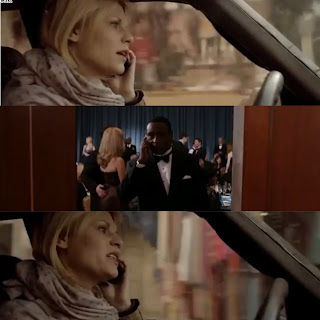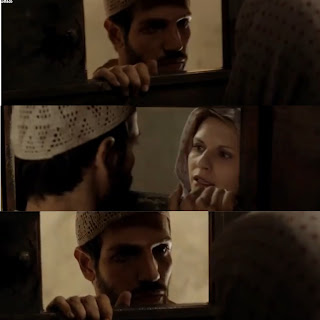27 March 2020
Media Studies
Representation essay - Holiday Homework Task 1
•
In the clip “Homeland”, contrasts in both wealth/status and race/regional identity are established. A typical white American woman who appears to be roughly middle-aged is contrasted to numerous men who appear to be Iraqi (differences in race). One is aware that these men are Iraqi because of their wearing of scarves around their heads and the Arabian women around them also wearing keffiyehs (costumes) to conceal certain parts of their bodies, which are all typical symbols and forms of iconography regarding Iraq. In some sense, the white American woman is respecting their beliefs by wearing a cloth around her head as well. The main contrast here, is the difference in skin tone, as well as accent, and most probably beliefs. Also represented, is an African-American man, here introducing a contrast in wealth and authority, whom the woman is also contrasted to. He is represented as being wealthy, powerful and calm. In contrast, the white American women is represented as being distressed, all over the place and desperate, later in the clip begging him not to put the phone down on her in a distressed manner. It’s as if she is dependent on him for some sort of information, guidance, trust or permission. This supports the typical gender stereotype of men being calm, cool and put-together, superior to women, who are ‘emotional' and dependent. His being wealthy is also contrasted to the poor lifestyles of the Iraq's depicted.
Effect has been created through miss-en-scene... The setting of the clip appears to be a poor, unclean settlement in Iraq, known as Baghdad. This is depicted by both the opening establishing shot and the opening sequence of the clip, with the word 'Baghdad' (printed language) appearing on the screen. As mentioned in the previous paragraph, the woman appears to be respectful of the Arabian culture, thereby wearing cloths for coverage. This emphasises her desire for some sort of information from the Arabians in some sort of way, no matter what it takes. The inhabitants of the area are all dressed in brown and black, darkly-coloured pieces of clothing (costumes) which appear, in some cases, to be torn. This relates to their less wealthy, less civilised backgrounds and lifestyles. In contrast, the African-American man wears a smart black tuxedo, the colour black representing his dominance and authority. This is consolidated by his being the “C.I.A. Deputy Director”, as said by the American woman. Those surrounding him are dressed in similar tuxedos and fancy ball dresses, their smarter attire relating to their wealthier lifestyles.
Hand-held camera shots and shaky camera movements in the scenes revealing Baghdad highlight the stress and uncertainty of the area and its inhabitants. Unstable and unsafe. The camera often zooms in from a farther shot, to a closer shot, quite quickly, enhancing that rushed, unstable atmosphere. An example of this are the two shots of the woman on a phone call whilst driving her car. Here, the jumping/zooming in closer toward her face encourages the viewer to pay closer attention to what she is saying on the call, highlighting the fact that she is dependent on the man, David, who is on the other side of the call, for something. Loud surrounding sound effects of cars and people shouting and talking loudly (sound) all create a sense of busyness and rush. The diegetic sound (also sound effect) of the woman’s car pulling to a standstill and her honking the hooter, followed by the shot revealing the blockage/traffic of the area, furthermore emphasise the bustling busyness and lack of rest she is surrounded with. As the woman stands out of her car and begins walking, one is able to see the large number of Arabians walking about around her, relating to their lack of finance to purchase cars. The diegetic music over these scenes is very quiet, and appears to be the sound of the traditional singing/humming by Arabians in the distance. It is not completely clear whether that singing is ‘live’ or rather a soundtrack being played by Arabians in the area. Either way, it furthermore sets the scene of the location being Baghdad, also making the scene seem less movie-like and more believable.
The busyness of Baghdad is in complete contrast, once again, to the setting of the man of mixed race, who appears to be attending a smart, high-end dinner. Here, the camera is stable and rigid, perhaps filmed using a steadicam, correlating to the wealth and stability of those attending. David speaks with authority and clarity, his voice calm and clear, opposite to the woman who is rushed and stressed. Where he is located, the room is coloured with welcoming lighting and gentle music, nothing like the loud, abrasive shouting and disruptive sounds of car hooters in Baghdad, where the woman is located. This proves the contrast between the American man and woman in terms of location, power and emotion. In both cases, close-up camera shots highlight the frown lines and emotion of both characters; David is calm and has clarity, the woman is emotional and desperate. His putting the phone down on her emphasises his dominance.
During the phone call, a cut-away/cross-cutting of the shot reveals an over-the-shoulder shot of the character (who the two Americans are speaking about on the call) looking out of the jail window at two men preparing the ropes for hanging someone (him!). This shot links to what the woman is saying on the call where she questions why he has been “locked up for almost a year,” and now all of a sudden, "overnight", the officials have “decide[ed] to hold a trial and pronounce a death sentence...” for him. David’s response referring to the man's blowing up “129 civilians” expose him as perhaps having been a terrorist. Stereo-typically in society, terrorism is something often paired or associated with Arabic individuals and groups.
Continuity editing throughout creates an easy-to-follow sequence where the viewer is not confused by what is happening in the story. However, there is the use of cutaways/intercuts (editing) during the phone call between the American man and woman as they discuss an important matter which, along with the close-ups revealing the emotion of the characters, intensifies the call, creating an engaging sequence and bringing it to life for the viewer, captivating them, furthermore highlighting the importance of the phone call. The use of quick cuts and continuously alternating camera shots (editing) in the scenes of Baghdad relate to it’s busyness, discussed above.
It’s as if the woman works for the same company or organisation as David, but at a lower level. Her inferiority against him is also in contrast to her sense of power in Baghdad. Although when she talks to David she appears distressed, as soon as the phone call ends, it’s as if a sense of determination rises up within her. This is evident in her fast-paced, confident walking towards an Arabian man further down along the gravel path. In this case she is followed by a track shot where the viewer feels as though they are walking right behind her, involved in the action. The two shot of her handing the Arabian man money, followed by her questioning of “Can he get me inside or not?” reveal her determination and build up a sense of something questionable and perhaps even illegal taking place. His accepting the money is a symbol of illegal, questionable activity and a highlighter of the poorer lifestyles in which these depicted Arabians are willing to accept bribes.
Following the conversation with the Arabic man, the woman is lead into the jail. In the distance, the quiet sounds of shouting and arguing can be heard. On entering, one can hear the diegetic sound of the keys jingling as they hit and bounce off one another, and the sound of the jail gate being opened. The jingling is loud and disruptive in such a quite and eerie location of the jail. The jail’s lighting is dark and dingy, the low/dim light barely illuminating the room. This dark lighting correlates to the dark activities and wrongdoings that are committed by those located in the jail. The shot that the viewer is shown of the character in the jail cell is almost like a point-of-view shot of what the woman sees when she begins talking to him. In this shot, the camera is positioned so that is faces the gap/window of the cell door, creating a sense of the viewer standing in the jail, just outside of the cell, adjusting their head in effort of trying to see the character through the door’s window, just as the lady does. This engages and captivates the viewer, creating effect.
The woman’s determination discussed earlier is consolidated by both her slapping the Arabic man when he insists that she leaves the jail area before the guards arrive and her non-gentle tone when saying “Prove it! ....Unless you do, I won’t protect your family," when addressing Ibrahim. Here, the conversation is displayed using shot-reverse-shot (editing), as well as the use of over-the-shoulder shots of both characters as they respond to the other. This specific sentence mentioned above reveals an aggression from a fierce place of wanting to help, but it is unclear whether it is for her own benefit or the benefit of Ibrahim that she wants to help. It’s as if she is bribing once again because she believes he has information that would be useful to her. Her slapping the Arabic man, the aggression in her tone, and the root of her cause (of her being willing to help his family as long as he provides her with important information), challenges the typical stereotype of women being gentle, caring and selfless. Perhaps she is only there to help so that she can receive information that will assist her cause, or perhaps she genuinely longs to help... it is not clear.
When the guards finally enter, and Ibrahim whispers something into her ear, she is pulled and marched away.... at this point, Ibrahim is heard yelling out “My family, my family! You promised to protect them,” and the scene fades to black...
Here, the diegetic sound of the guards on entering the passage, along with their shouting and pulling her away symbolise a ruthless behaviour and aggressive treatment of women. This could relate to the harsh living circumstances of Iraq and it's society.
Opening establishing shot of Baghdad
Cutaways and cut backs during phone call
Over-the-shoulder shot of the man, Ibrahim, in prison
The American woman handing something to the Arabic man
Over-the-shoulder shot of the woman speaking to Ibrahim
Shot-reverse-shot of their conversation








No comments:
Post a Comment